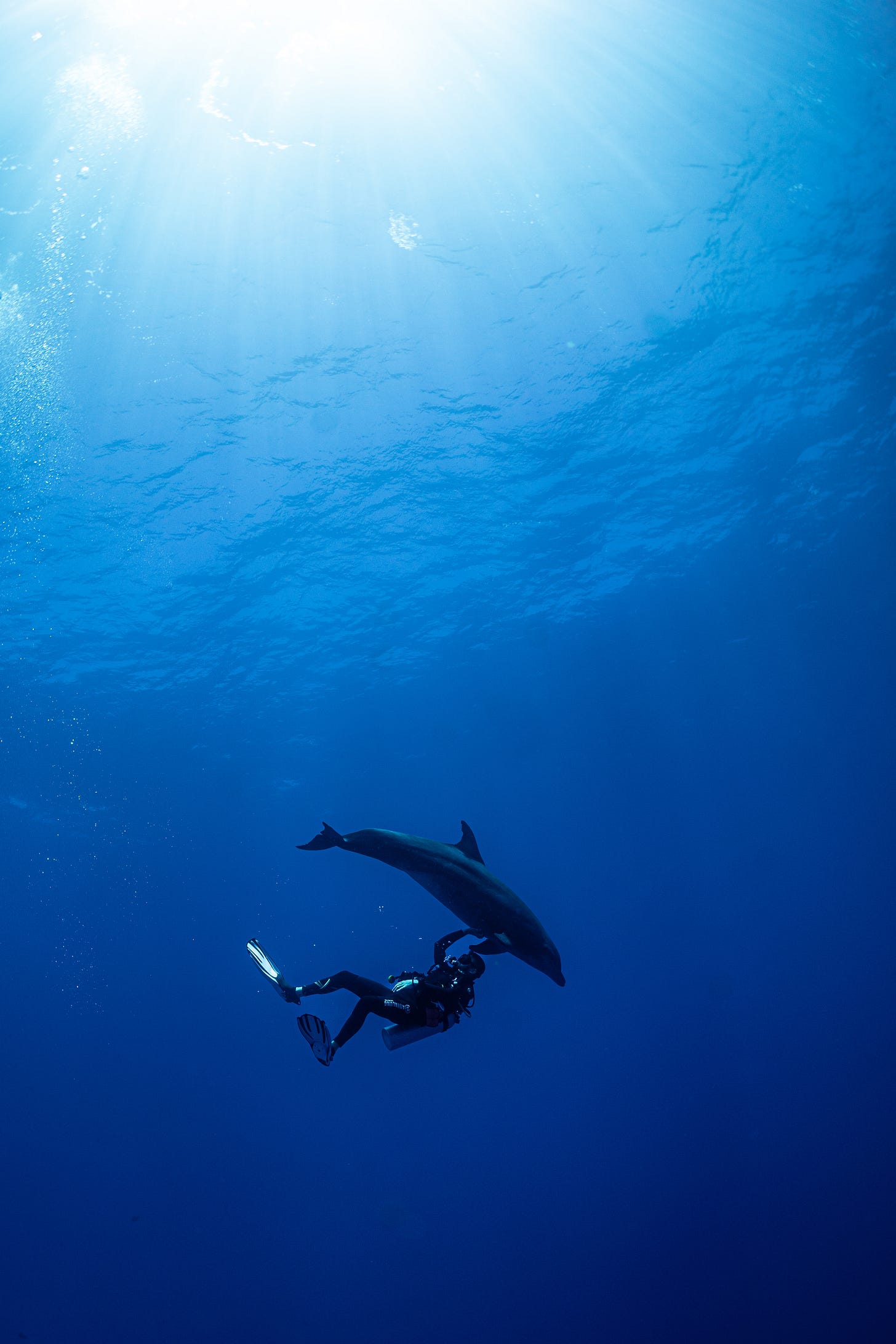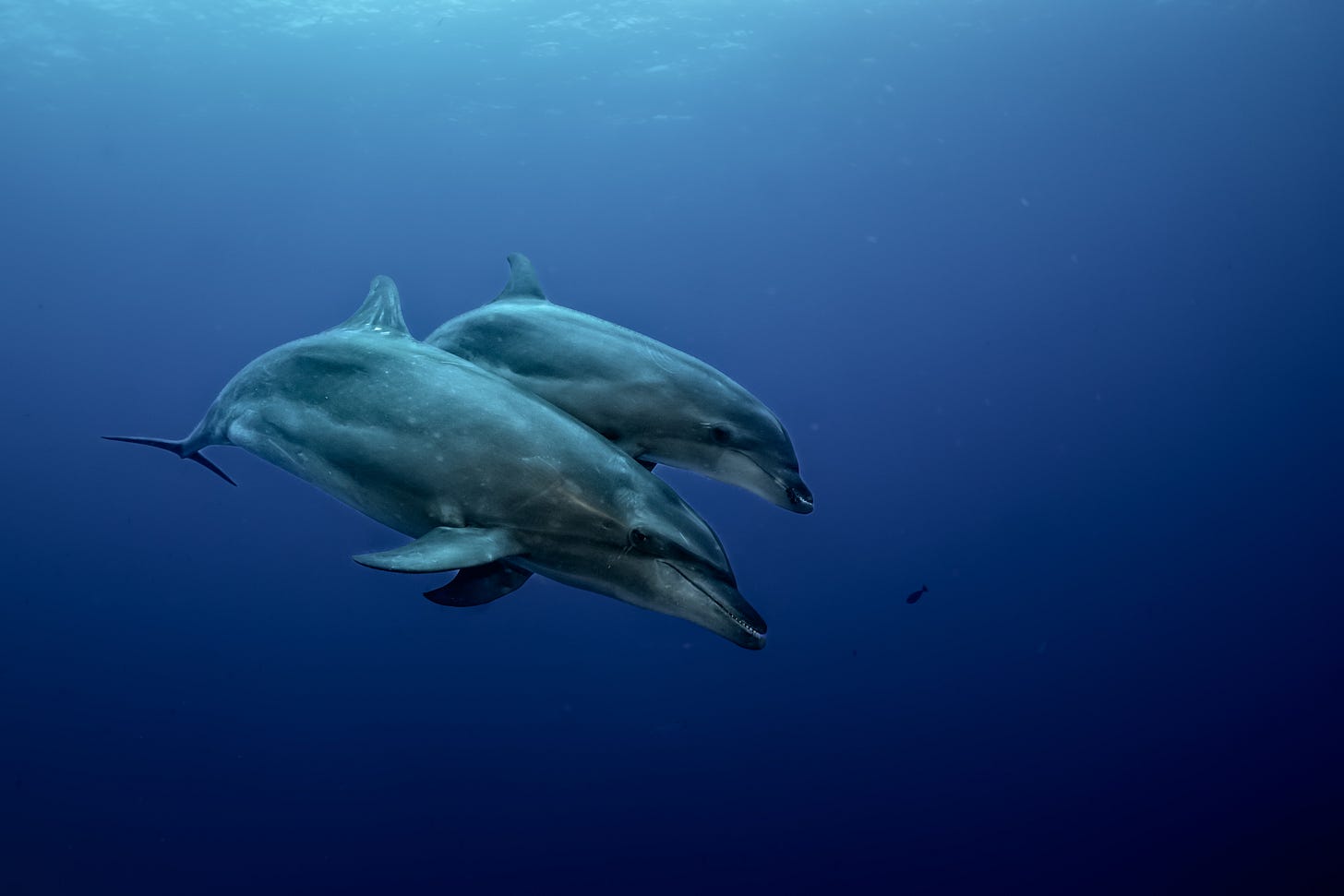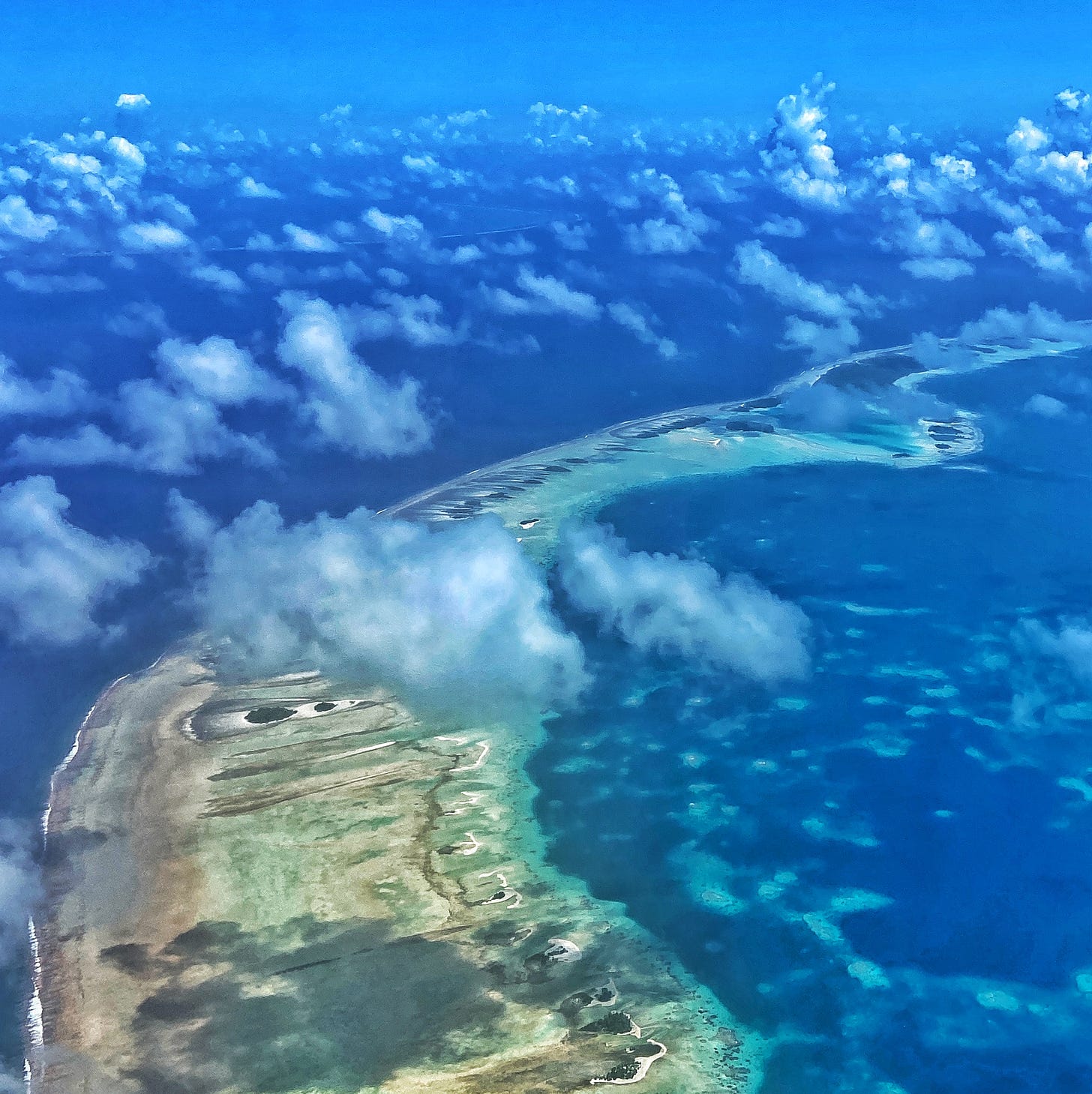Rangiroa Dispatch
The not so silent world
In 1956, the Jacques Cousteau film, Le Monde du Silence, was released to great acclaim. One of the first feature length movies to show the underwater world in color, it won the prestigious Palme d’Or at the Cannes film festival, the only documentary to hold that honor until 2004. The movie’s title, which was the same as that of Cousteau’s 1953 book, translates to “The Silent World” in English, but even by Cousteau’s admission, this was a misnomer. The underwater world is anything but silent. Fish grunt, they squeak, they chew on coral, and rocks sing as they tumble on a strong current. The whistles and haunting songs of whales, orcas, and dolphins can be heard for miles. And then, of course, there is the whooshing gurgle and clank of those of us who visit the aquatic realm for an hour at a time with noisy scuba gear and our own exhalations.
I heard the dolphins before I saw them—distant whistles coming from somewhere above. Or was it below? Underwater, sound carries differently and is difficult to discern direction. Our small group had dropped down to 60 feet along the outside reef of the Rangiroa coral atoll and were cruising towards the famous Tiputa Pass, when the dolphins started singing. Our guide, Romain, got our attention and beckoned us to follow him. He swam out, away from the sloping reef, into the blue, endless expanse over the deep abyss. The bottom drops away here and the reef disappears so the sensation is that of a spacewalk, with little reference for up and down other than your depth gauge or the shimmer of the surface far above. More whistles. Then, streaking down into view were two dolphins, then three, then five…
These were not the shiny scrubbed captive performers from an aquarium, but covered with scars, bite marks and torn dorsal fins. Still, they all had the intelligent eyes and grin that is the dolphin’s trademark. They approached us with no fear. This was their realm. We were visitors, a clumsy clutch of curiosities to them, and all of the dolphins danced and swooped between, then below, then above us, over and over. To see these large, intelligent marine predators up close gave me pause. But they were here to play. Romain, who is familiar to this pod from hundreds of dives, gestured to the dolphins and they approached him like an old friend, pausing for a scratch, a dance, a pat on the belly, before arcing away, then back again. It went on like this for over 10 minutes. Camera shutters and strobes fired all around as we tried to capture the scene. One has to be careful not to lose track of one’s air supply, bottom time, and depth. The dolphins are true sirens of the sea, and Romain had warned us not to become so mesmerized by their songs as to follow them down too deep. A dolphin is capable of diving to over 900 feet, a scuba diver, not so much, and the reef outside the atoll drops off precipitously.
Coral atolls are a sort of palimpsest of the Earth’s history, a shadow image left behind. Each one formed as a coral reef surrounding a volcanic peak that would have risen from the sea millions of years ago. When the mountain eroded away into the deep, it left behind only the reef that traced its circumference. As sea levels dropped, the reef became a loop of shallow land that birds, airborne insects, and seeds colonized, and then grew into a scrubby ecosystem. Then, inevitably, came the humans. In the Pacific, it was the Polynesians who first made these necklaces of islands and atolls their watery home, in a huge triangle from New Zealand to Rapa Nui, north to Hawai’i.
Rangiroa, one of the largest atolls on the planet, is at the heart of the Polynesian Triangle. Its name means “vast sky” in the Tuamotuan language, but it wasn’t the expanse of the heavens that made the greatest impression on me. It was the raw wildness of this remote ring of coral in the middle of the Pacific Ocean. By comparison, the Caribbean feels quaint and almost compact, relatively tame. In French Polynesia, the distances are great, the abyss deep, the currents mask-ripping strong, and the creatures big. Even from shore, we saw blacktip reef sharks patrolling the shallows, hunting at dusk. One day, two eagle rays splashed about in a noisy mating dance, not 10 meters off the beach. And in the depths of the Tiputa Pass are huge schools of sharks, defying the current to hunt and to let the water pass over their gills to breathe.
The king of Rangiroa’s watery realm is the Sphyrna mokarran, the great hammerhead shark. The Polynesians call it tamataroa, and revere it. An apex predator in this part of the Pacific, the great hammerhead can grow close to 15 feet in length, with a massive dorsal fin and that trademark cephalafoil head. Yet it is a cautious, elusive animal, wary of divers. This makes it difficult to observe, tag, and study in their natural environment. Not to mention they hang out in the deep canyon of the Tiputa Pass, where they circle for reasons not yet fully understood, then ride the current into the massive lagoon inside the atoll. The sharks are frightened by divers’ bubbles, and their noisy exhalations, making them difficult to approach for photography, take tissue and blood samples, or affix a tag on their fins for tracking.
In a scruffy basecamp on the tip of the atoll next to the Tiputa Pass, lives a team of scientists, photographers, and volunteer divers who have made it their mission to unravel the mysteries of the mighty mokarran. The group is called the Mokarran Protection Society. By day they go diving, some with cameras, some with modified spearguns for tagging, and some with homemade laser survey devices for triangulating the size of the sharks. The group has enlisted the help of Gombessa Expeditions, who can best be described as a modern day equivalent of Cousteau’s band of French divers aboard the Calypso. The Gombessa team is led, fittingly, by the renowned French marine biologist and photographer, Laurent Ballesta, a modern heir to Cousteau’s legacy. Over the past decade, he and his team have carried out audaciously groundbreaking expeditions to document the elusive coelacanth fish, go deep in Antarctica, and photograph congregations of 700 sharks at night in another Polynesian atoll. Their specialty is difficult diving—deep, cold, dark, you name it—in the name of science and art. Their weapon of choice for these exploits is a key to their success: the closed circuit rebreather.
Forget the wasteful, noisy clouds of exhaled bubbles from a standard scuba kit. As its name suggests, a closed circuit rebreather has no exhaust. A diver’s exhalations are looped back through the system, the carbon dioxide “scrubbed,” additional oxygen added as needed, then “rebreathed” by the diver. It is efficient, it is quiet, and it allows divers to stay down longer since they’re not simply draining a tank one breath at a time. Ballesta once made a 24-hour dive, only swapping rebreathers three times. The average dive can last around three hours. All of the advantages of a rebreather (which, in cruder forms, has been around since the 1940s) make it perfectly suited to the study of skittish critters like the great hammerhead. In Rangiroa, the Gombessa team and some of the Mokarran Protection Society divers, use rebreathers to perform long dives at 150 feet, where they can remain for hours, quietly observing the sharks. In turn the sharks sometimes muster up the courage to come closer to observe these odd new visitors, allowing the divers close encounters, enabling tagging and photography.
Though most of my dives in Rangiroa were done the old fashioned way—open circuit scuba—I also had the chance to try out a rebreather one day. After learning the principles of its operation and some tips on its use, I descended on a shallow site inside the Tiputa Pass accompanied by an instructor. I’d been told by experienced rebreather divers that the primary difference in technique relates to the different buoyancy characteristics. Since you’re not inflating your lungs with a new gulp of compressed air, then emptying them into the water, you don’t control your buoyancy with your breath like you do on an open circuit rig. Typically on scuba, inhaling will cause you to rise slightly in the water column, and exhaling makes you sink. With a CCR (closed circuit rebreather) it’s almost the opposite. Air volume is constant, but balanced in a small pair of inflation pouches called “counter lungs” on your back. When you exhale, these fill, causing you to rise. To sink, you must exhale slightly through your nose, which then sneaks out past the mask seal, evacuating some of your air, causing you to descend. It is said that with rebreather diving it is easier to swim around obstacles than go up and down over them. It’s also easier to go deeper. Just when I thought I had the hang of it, I would find myself rising towards the surface or, conversely, crashing to the sandy sea floor. But during my roughly one-hour dive, there were moments of serenity and neutral buoyancy and I was able to appreciate the relative silence, no longer waiting for the roar of bubbles blowing past my ears. I was able to approach a school of fish as if they didn’t notice me. A blacktip reef shark swam past, unconcerned. Diving open circuit, one is always conscious of a dwindling air supply, so you tend to breathe cautiously, more measured. Absent this concern, I could have remained for two more hours, or longer, limited then only by my body’s core temperature or fatigue.
The rebreather unit looks like something an astronaut would wear on a spacewalk. Open up its hinged hard shell case and one is met by a tangle of hoses and cables, straddled by two small cylinders, which hold pure oxygen and air. Electronics with redundant backups do all the hard calculations to maintain a perfect balance of oxygen and nitrogen, fine tuning gas delivery depending on a diver’s depth. Once you learn to trust the technology, rebreather diving could become addictive with its long bottom times, reduced narcotic effect, and utter silence.
Along with trying out the closed circuit rebreather, I was also able to try out a new kind of dive watch—the Blancpain Fifty Fathoms Tech “Gombessa”—developed specifically for closed circuit diving and as a tribute to the Gombessa team and their ten years of collaboration with Blancpain. This watch was actually the reason I was in French Polynesia to begin with. I had been invited there by Blancpain to act as moderator for a web stream launch event for this new watch. On the panel was Ballesta, who actually shares the patent with Blancpain for the new watch, as well as Blancpain’s CEO, Marc Hayek, along with one of the Mokarran Protection Society’s scientists, and Blancpain’s VP of sales.
Given this background, you are forewarned to read my opinions on this new watch with a pinch of salt, but in all honesty, I actually believe it is one of the most innovative modern analog dive watches in recent memory. While so many brands are focused on depth ratings, it’s not depth that is the big challenge to modern professional divers. It is time. Rebreather divers have little use for the outmoded 60-minute time scale found on just about every dive watch since, well, Blancpain invented the genre in 1953. When Ballesta was wearing a Blancpain Five Hundred Fathoms watch (a different model) five years ago, he got to thinking that that watch’s 24-hour hand, which was used to track a second time zone for travel, could perhaps be modified to track three-hour durations, alongside a new bezel time scale. He approached Blancpain with his proposal and the rest, as they say, is history.
I think the innovation of the Fifty Fathoms Tech watch is not the movement itself — that is simply a differently geared fourth hand, made to circle the dial once in three hours. To me, the brilliance is the fact that Blancpain listened to a modern diver on the cutting edge of work and technology, and just thought differently than any other brand to make a simply elegant solution. Any watch can be made to go to 1,000 meters strapped, for bragging rights, on the outside of a submersible. But divers like Laurent Ballesta don’t need that. They need something to time longer dives, and not with an illegible chronograph. Of course, the rest of the watch is icing on the cake—the titanium reinforced strap that integrates with the case, the light absorbing deep black dial, the helium release valve (added to accommodate Ballesta’s time in a helium-saturated environment), the high grade titanium case, and so on. I happen to think the Tech is one of the only truly new innovations (albeit very simple) to suit modern diving needs in an analog watch. Blancpain didn’t need to reinvent the wheel. They just found a new way to use it, using small modifications, and a lot of field testing. Ballesta dove with a prototype of this watch while rebreather diving out of a saturation environment at the bottom of the Mediterranean for a whole month and hundreds of hours. I’m not sure another brand has the commitment to diving that Blancpain does (Hayek himself is a rebreather devotee and passionate diver). This is an expensive, niche tool built for a very specific use in an arcane discipline. And I love that it exists.
I’ve written many times that it was the purchase of a dive watch that spurred me to learn how to dive. Similarly, would I become a rebreather diver if I owned a Fifty Fathoms Tech? To remain proficient with a rebreather, I would need to be diving with it a lot. Then there are the travel complications of packing one along, sourcing the correct CO2 absorbent, and getting oxygen fills onsite in remote corners of the world. For now, I will remain a relative Luddite with my heavy tanks, noisy bubbles, and standard Fifty Fathoms with its 60-minute bezel, that is perfectly adequate for most of my dives. That is, until I move to Rangiroa and join the Mokarran Protection Society. Never say never.
Back on the Rangiroa reef, the dolphins didn’t seem to mind our noise and bubbles. In fact, they seemed to enjoy them. Perhaps it’s what alerted them to our presence, and perhaps there is some deep, primal kinship with us fellow air breathing mammals who need to return to the surface from time to time. Other sea creatures don’t make bubbles—just those of us with lungs. Just as quickly as they arrived, the dolphins vanished, a few powerful flips of their tails and all that was left were their squeals and whistles. Exhausted and exuberant, we rounded the corner of the reef and approached the growing current at the Tiputa Pass, where we surrendered to the in-rushing tide. The flow grew in strength and we drifted like leaves in a rainstorm, flushed into the lagoon. Below on a ledge, defying the force of the water, was a school of reef sharks, barely finning yet stationary. Further below, somewhere in the prehistoric depths of this ancient place, invisible and yes, silent, the mighty tamataroa circled. But our time was up. Time to return to the noisy world above.









What an fantastic story Jason! Pieces like this are what makes you the best in the industry.
Talk about having a vicarious thrill from your amazing experience! Thank you, Jason, for sharing the beauty and adventure of your trip. I also enjoyed your discussion of traditional and current diving technologies and their impact on your experience. I am now going to enviously revisit yours and Gishani's IG feeds about this incredible trip. 😎